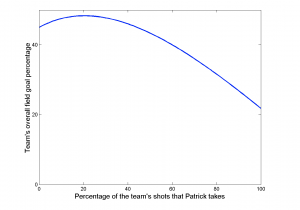Braess’s Paradox on the Basketball Court
Braess’s Paradox on the Basketball Court
Source: Snellings, Ryan. The LA Clippers could be beneficiaries of “The Ewing Theory.” 2017< https://clipperholics.com/2017/10/04/la-clippers-beneficiaries-ewing-theory/>
BRIAN. Braess’s Paradox and “The Ewing Theory” MAY 28, 2009. Blog: Gravity and levity. < https://gravityandlevity.wordpress.com/2009/05/28/braesss-paradox-and-the-ewing-theory/>
Braess’ Paradox, proposed by German Mathematician Dietrich Braess in 1968, has been widely used to explain the myth of traffic congestion problem especially in large cities where has developed road systems. The paradox holds that the addition of a new road, supposed to reduce the traffic pressure, does not bring effectiveness in reality. Even though seemingly counter-intuitive, the model explains that the drivers would selfishly switch to the new road that designed to save time, therefore with a large density of the flow the new road would be even more crowded than the old route, increasing the traffic pressure. The theory is an important subject in the study of the game theory. Besides the field of city planning, Braess’s paradox also extends to the sports world.
In NBA, there is a very similar concept to Braess’s paradox called the Ewing Theory, proposed by a sports column reader Dave Cirilli in the mid-1990s. He developed the theory to explain the phenomenon that every time Patrick Ewing, known as one of the 50 Greatest Players in NBA history, was absent from the game for injuries or foul troubles, the overall team would “inexplicably” performs better. The myth occurred at both of his team New York Knicks and Georgetown Hoyas. The situation qualifies Ewing Theory with two criteria:
- The star earns mass attention from the media and fans while the team fails to receive substantial win with him.
- The public immediately write off the team as this star player leaves.
In 2017, the Clippers losing Chris Paul, one of the best point guards in the recent years, raised the conversation of Ewing Theory again and offered some insights to explain the theory. According to the article, many held positive predictions of the team performance after Paul’s departure. With Paul joining the team, the Clippers still could not reach its breakthrough point as expected. After Paul left, the Clippers could best utilize the athleticism of other two stars Gallinari and Williams. A following game in Hawaii shew that the new playmaking gave DeAndrew Jordan and Griffin opportunity to stretch, and the arrival of Beverley could enhance the culture of the team by “forging a new tough identity of the team”. The example offers an insight of the Ewing Theory from a qualitative perspective: without the star player, the other players’ potentials and advantages could be better explored and utilized under a new game strategy. The gap between the actual team performance and the star’s reputation would also discourage the entire team. (Snellings)
From the quantitative perspective, the basketball playing strategy is a network problem. In the theoretical model, suppose that Ewing’s teammates have 45% shooting rate, which is lower than Ewing’s 60%, so the teammates “selfishly” would pass the ball to Ewing, as the driver would choose the new route. However, the truth is due to the law of diminishing returns Ewing’s performance decreases as more ball he takes. As the graph shows only at 21% of the team shots Ewing has, the team could reach the peak. In the situation where Ewing is gone, the Nash Equilibrium strategy is having five equally regular players with 45% shooting rate share the ball instead of focusing on one. This 45% rate does not change with the presence of Ewing. However, Ewing might do not performance well and other player could not utilize their skill because they all pass ball to Ewing. In the new strategy, the team attempt to reach the Nash equilibrium by having all five regular players shoot with 45% rate. (Brian)

